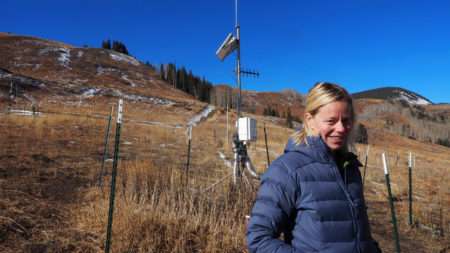 The European Association of Geochemistry honored Jill Banfield with the 2020 H.C. Urey Award, which is given “for outstanding contributions advancing geochemistry over a career.” Read more »
The European Association of Geochemistry honored Jill Banfield with the 2020 H.C. Urey Award, which is given “for outstanding contributions advancing geochemistry over a career.” Read more »
Jill Banfield Receives 2020 H.C. Urey Award
Shale is an Important Source of Organic Carbon in Floodplain Sediments of a Mountainous Watershed
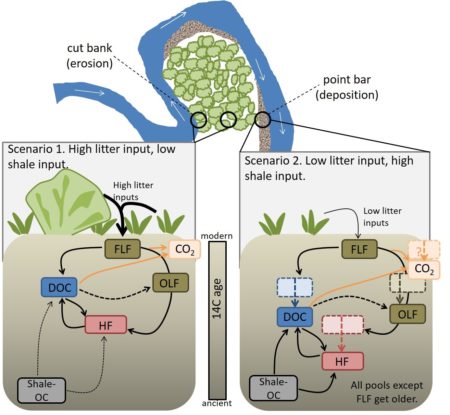
Conceptual diagram showing two scenarios: (1) high litter input with low shale input, and (2) low litter input with high shale input. Scenario 1 is emblematic of regions of the floodplain with more extensive soil development (e.g., cut bank and middle of the meander) and non-shale systems, where OC is derived primarily from plant detritus and the 14C age is controlled by occlusion of litter fragments in aggregates (OLF), which physically protects it from degradation, and mineral protection of processed OC (e.g., partially oxidized and degraded) through adsorption or occlusion within mineral particles (HF). Scenario 2 (point bar) represents a shale-rich environment with low litter inputs, where the OC is derived from both shale and plant litter and 14C age of all pools except for FLF is lowered by the presence of shale-derived carbon. The role of shale-derived OC in CO2 release is currently unknown.
Shales contain high levels of organic carbon (OC) and represent a large fraction of the earth’s carbon stocks. Recent evidence suggests that shale-derived OC may contribute to the carbon cycle in some riverine systems, however this process is poorly understood and not currently considered in global C models. Through detailed sediment analysis coupled with radiocarbon measurements, and synchrotron carbon spectroscopy, this study determined the abundance, chemistry, and mobility of shale-derived OC in floodplain sediments of a shale-rich mountainous watershed.
Radiocarbon measurements reveal that 23-34% of OC in East River floodplain sediments is derived from shale, including types of sediment-OC which are considered to be relatively mobile and available for use by microbes. While the contribution of shale-derived OC to CO2 production and export is currently unknown in this system, the observation of shale-derived OC in carbon pools which is actively cycling suggests that this topic warrants further research. The results demonstrate the importance of shale weathering in the floodplain, particularly under low plant-litter environments, with implications for the global carbon budget and other shale-associated elements, including growth-limiting nutrients (e.g., N) and toxic elements (e.g., As, Se, U).
Summary
Shales contain high levels of organic carbon (OC) and represent a large fraction of the earth’s total carbon stocks. While recent evidence suggests that shale-derived OC, which is millions of years old, may be actively cycled in riverine systems, this process is poorly understood and not currently considered in global C models. In this study, the authors analyze sediments collected from the floodplain of the East River, Colorado, located in a high-elevation mountainous watershed underlain by shale bedrock, to determine the importance and mobility of shale-derived OC in this environment. OC closely associated with sediment minerals is the largest (84 ± 6%) and oldest OC pool, containing a large, but variable, amount of shale-derived OC. Evidence of shale-derived OC is also observed in other sediment OC pools which are considered to be more mobile and more easily degraded to carbon dioxide by bacteria (e.g., water-soluble). Carbon spectroscopy revealed that floodplain sediments had a higher degree of functionalized aromatic groups and lower carbonate content compared to shale collected nearby, consistent with chemical alteration and mixing with other C sources in the floodplain. This study concludes that there are two primary OC sources in floodplain sediments, plant-litter and shale-derived OC, each with distinct chemical characteristics and reactivity. The authors estimate 23-34% of the sediment OC is derived from shale, demonstrating the important contribution of shale-OC to the carbon cycle at this site, particularly in environments with low plant-litter inputs.
Citation
Fox, P. M., Bill, M., Heckman, K., Conrad, M., Anderson, C., Keiluweit, M., and Nico, P. S. “Shale as a Source of Organic Carbon in Floodplain Sediments of a Mountainous Watershed.” Journal of Geophysical Research: Biogeosciences, 125, (2020). DOI: 10.1029/2019JG005419
Susan Hubbard Elected to National Academy of Engineering
Heidi Steltzer Profiled in Colorado Sun Newspaper
Heidi talks to an independent newspaper about SFA early snowmelt experiments and how findings are linked to earth system models to improve predictions under a changing climate. Read more »
Seasonal snowmelt drives changes in alpine stream bed microbiome structure and function
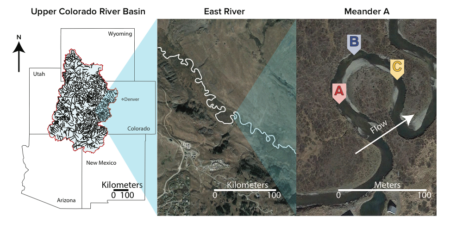
Location study site within the East River near Crested Butte, CO, part of the Upper Colorado River Basin.
Within the East River, near Crested Butte, CO, shifts in microbial composition and activity were observed in both stream water and the streambed associated with water mixing patterns, highlighting the tight linkage between microbial community assembly and function, and seasonal changes in hydrology. Specifically, rates of aerobic respiration increased during spring snowmelt, linked to the influx of abundant dissolved organic carbon. Moreover, strong river water downwelling into the riverbed had the additional effect of homogenizing the microbial community composition across depth profiles through the bed.
This work revealed multiple close linkages and feedbacks between physical, chemical, and microbiological processes in headwater streambed ecosystems, and highlights the need for increased characterization of upland biogeochemical cycles under future climate change scenarios.
Summary
Seasonal changes in river discharge in upland watersheds affect patterns of surface and groundwater mixing in the hyporheic zone (the region in the riverbed where these two water sources interact) that impacts how carbon compounds and dissolved metals are processed and exported from such catchments. This study focused on seasonal patterns of hyporheic mixing in the East River, CO, where seasonal snowmelt drives large fluctuations in the annual hydrograph. Using in situ depth-resolved temperature loggers and discrete sampling of pore fluids and riverbed sediments, we demonstrated that snowmelt-derived runoff drives increased downwelling of river water into the riverbed. Conversely, the riverbed experienced a greater influence from upwelling groundwater under low- and base-flow conditions. The movement of dissolved solutes was strongly correlated with seasonal changes in flow. Under high river discharge, increased dissolved oxygen concentrations in riverbed pore fluids stimulated aerobic heterotrophic metabolism, while conversely, this activity was depressed under baseflow conditions. Linked to changes in microbiome function, we demonstrated that this dynamic hydrology also influenced microbial community assembly; strong downwelling river water conditions had the effect of homogenizing microbial community composition across depth profiles through the riverbed.
Citation
C. M. Saup, S. R. Bryant, A. R. Nelson, K. D. Harris, A. H. Sawyer, J. N. Christensen, M. M. Tfaily, K. H. Williams, and M. J. Wilkins. (2019). “Hyporheic zone microbiome assembly is linked to dynamic water mixing patterns in snowmelt‐dominated headwater catchments.” Journal of Geophysical Research: Biogeosciences, 124, DOI: 10.1029/2019JG005189
Spatial heterogeneity in streambed biogeochemistry
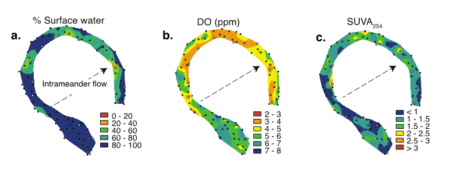
Intrameander flow paths result in lateral heterogeneity in streambed surface water-influence (a), dissolved oxygen (b), and specific UV absorbance at 254 nm (SUVA254, c, indicator of organic compound aromaticity). Water flow in channel is clockwise.
During baseflow within an alpine river, meander morphology was found to cause lateral spatial variability in channel hyporheic flow and drive streambed biogeochemical conditions. Sinuosity-induced intrameander flow paths affect the source and lability of dissolved organic matter, and streambed microbial community composition shifts with chemistry conditions, although communities are all similarly diverse.
The progression of climate change is resulting in earlier snowmelt onset and reduced snowpack in alpine regions, causing a longer baseflow period for alpine streams and subsequently impacting streambed flow and biogeochemical processes. This study characterized streambed biogeochemistry at high-resolution during baseflow to constrain how nutrient cycling in alpine watersheds may shift with climate change.
Summary
The authors conducted a high-resolution characterization of streambed hydrology and biogeochemistry around a prominent meander bend within the East River (Crested Butte, CO) and found sinuosity-induced heterogeneity in hyporheic flow, pore water chemistry, and microbial community composition. The presence of intrameander flow paths result in spatial heterogeneity in the upwelling and downwelling of water, and subsequent surface water influence in the streambed. Surface water downwells in a large recharge zone on the up-valley side of the meander, and discharges on the down-valley side of the meander. Variability in hyporheic flow resulted in similar patterns in pore water chemistry and concentrations of substrate for microbial metabolism. Regions of the streambed with large surface water influence have higher dissolved oxygen concentrations, relatively low metal concentrations, and more labile, fresh dissolved organic matter. Contrastingly, groundwater-dominated regions have low dissolved oxygen and high metal concentrations, and more recalcitrant dissolved organic matter. Lateral heterogeneity in pore water chemistry drives microbial community composition, although streambed microbial communities are similarly diverse. The authors’ findings enhance understanding of hyporheic biogeochemical conditions during baseflow, which is expected to lengthen with climate change.
Citation
A. R. Nelson, A. H. Sawyer, R. S. Gabor, C. M. Saup, S. R. Bryant, K. D. Harris, M. A. Briggs, K. H. Williams, M. J. Wilkins (2019), “Heterogeneity in hyporheic flow, pore water chemistry, and microbial community composition in an alpine streambed.” Journal of Geophysical Research: Biogeosciences, DOI: 10.1029/2019JG005226
Local CO News Describes Upcoming NASA Data Campaign at East River
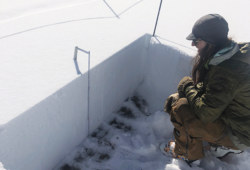 Crested Butte News highlights work being conducted by NASA and SFA collaborators in the Upper East River Valley. The NASA SnowEx project is collecting airborne data at East River (one of its three CO study sites this year) and is pairing this with ground observations taken at snow pits, an effort led by SFA collaborator Jeff Deems (NSIDC) in conjunction with Rocky Mountain Biological Laboratory staff. Read more »
Crested Butte News highlights work being conducted by NASA and SFA collaborators in the Upper East River Valley. The NASA SnowEx project is collecting airborne data at East River (one of its three CO study sites this year) and is pairing this with ground observations taken at snow pits, an effort led by SFA collaborator Jeff Deems (NSIDC) in conjunction with Rocky Mountain Biological Laboratory staff. Read more »
Deputy SFA Lead Kenneth H. Williams recently briefed the Upper Colorado NGWOS team in Denver, CO on observational activities and capabilities within the East River watershed that align well with potential tandem measurements to be made over much greater spatial scales by the NGWOS program in the greater basin. The ability to link measurement approaches affords an excellent opportunity to explore the role of spatial aliasing in creating a hydrogeochemical observational network.
Predicting sedimentary bedrock subsurface weathering fronts and weathering rates
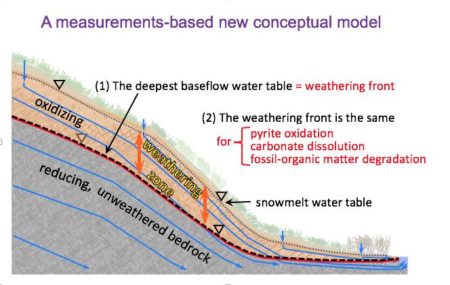
The new conceptual model coupling subsurface water table positions with weathering fronts of multiple minerals and components in sedimentary bedrocks. The water table remains approximately parallel to the soil surface along the hillslope. The deepest seasonal water table determines the pyrite weathering front. Carbonate minerals and fossil-organic matter share the same weathering front with pyrite.
For the first time, subsurface bedrock weathering rates were directly determined from in-situ measurements. The weathering front coincides with the depth of deepest seasonal water table for sedimentary bedrocks. Carbonates and rock organic matter share the same weathering front depth with pyrite, contrary to models that stratify their weathering fronts.
This new conceptual model linked to subsurface hydrology makes predictions of bedrock weathering fronts and rates more feasible, and connects to water quality and climate change impacts. The approach can be applied to other settings of a watershed.
Summary
Although bedrock weathering strongly influences water quality and global carbon and nitrogen budgets, the weathering depths and rates within subsurface are not well understood nor predictable. Determination of both porewater chemistry and subsurface water flow are needed in order to develop more complete understanding and obtain weathering rates. In a long-term field study, this study applied a multiphase approach along a mountainous watershed hillslope transect underlain by marine shale. Three findings are reported in the study. First, the deepest extent of the water table determines the weathering front, and the range of annually water table oscillations determines the thickness of the weathering zone. Below the lowest water table, permanently water-saturated bedrock remains reducing, preventing deeper pyrite oxidation. Secondly, carbonate minerals and potentially rock organic matter share the same weathering front depth with pyrite, contrary to models where weathering fronts are stratified. Thirdly, the measurements-based weathering rates from subsurface shale are high, amounting to base cation exports of about 70 kmolc ha−1 y−1, yet consistent with weathering of marine shale. Finally, by integrating geochemical and hydrological data, a new conceptual model is presented that can be applied in other settings to predict weathering and water quality responses to climate change.
Citation
Wan, J., Tokunaga, T. K., Williams, K. H., Brown, W., Dong, W., & Hubbard, S. S., Predicting sedimentary bedrock subsurface weathering fronts and weathering rates. Scientific Reports, 2019, DOI: 10.1038/s41598-019-53205-2
Fadji Maina Included in Forbes’ ’30 Under 30′ List

Fadji Maina, Earth and Environmental Sciences Area, gives her presentation “Sustainable Water for an Uncertain Future” at the 2019 Berkeley Lab Research SLAM. 09/19/2019 Berkeley, California
Fadji Zaouna Maina (Berkeley Lab) is among Forbes Magazine’s 30 Under 30 list of “revolutionaries changing the course—and the face—of business and society.” Maina, included in the science category, uses computational models to better understand how climate change and pollution affect water availability. Read more »
To learn more about some of Fadji Maina’s research, watch and read Fadji’s pitch on “Sustainable Water for an Uncertain Future” (from the Berkeley Lab “Research SLAM”).
Watershed Function at AGU 2019

Photo credit: AGU
Researchers from the Watershed Function SFA will have a strong presence at the upcoming AGU Fall meeting, December 9 – 13, 2019.
22 Talks (8 invited)
28 posters
Chairing 6 special sessions
Leading 1 workshop
The SFA will also host a session at Booth #1622 in the North Hall, Wednesday December 11, 10:00 – 11:30 AM at the Berkeley Lab Earth and Environmental Sciences AGU booth.
A complete listing of the SFA’s AGU activities is available here.
The AGU Fall Meeting “is the largest international Earth and space science meeting in the world” and will take place at the Moscone Center in San Francisco. 2019 marks the 100th year of AGU.

